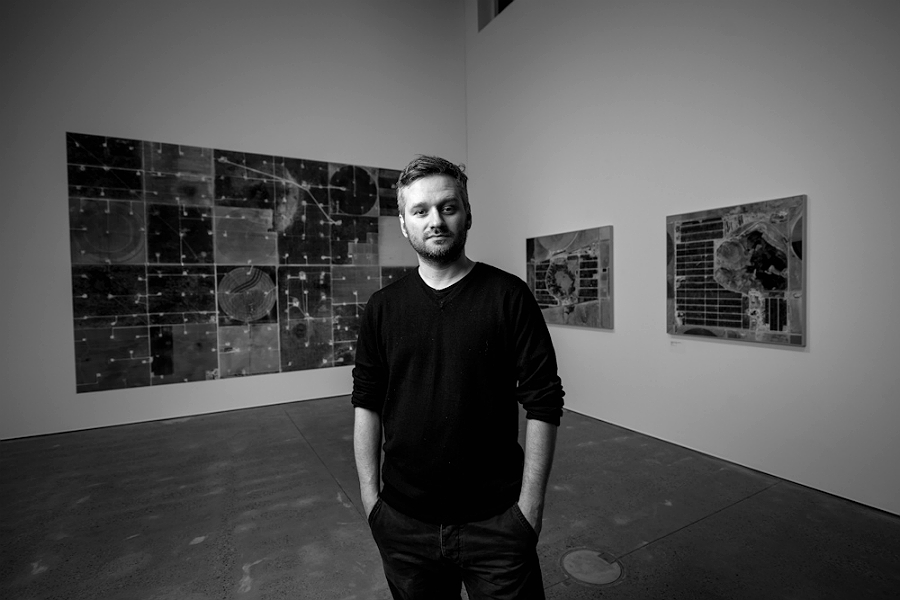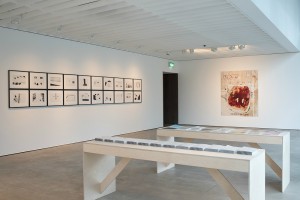Mishka Henner:
Precious Commodities

Nothing is what it seems in the Open Eye Gallery’s latest exhibition…
Arriving at the Open Eye Gallery for the latest exhibition, Mishka Henner’s Precious Commodities, you could be forgiven a genuine cartoon-style double-take. On first glance, the main pieces in gallery 1 look for all the world like paintings. Paintings in a photographic gallery? Isn’t that overstepping the remit a bit?
Move closer though; a bit closer still, and the images before you – which appear ever so painterly in both hang, and seemingly, texture – reveal themselves to be inkjet prints. But what of the content of the images? There’s no immediate sense of recognition – we overhear somebody, quite understandably, musing on whether or not they’re crop circles.
The dimensions and high level of detail (which Henner achieved through assembling hundreds of satellite images using the likes of Google Earth and Bing Maps) of the works – the sheer scale of which challenges and subverts conventional photography techniques – throw in yet another layer to test comprehension. In fact, they are studies of those mainstays of the American economy: the oil and beef industries.
Looking at Coronado Feeders, Dalhart, this knowledge quickly changes the perception of what’s in front of you. What is ostensibly a dry, parched-looking desert landscape, featuring a splash of oranges, reds and browns, is in fact an enormous cesspit for cattle. While we’re still taking this in, in the periphery of our vision the whole while is the even larger piece, Levelland Oil Field. Offering an extraordinary view of terra firma we’re unused to, it’s truly remarkable to see the shifts in colours and textures in a landscape carved up into neat squares, highlighting how the land has been appropriated to serve a practical purpose.
On the adjacent wall to the viewer’s left are a set of geological maps, initially used by the artist to study the landscapes before any work was created; dated from 1974-86, while the work is all from this year, they also serve to open a debate about man’s impact on environments and the sometimes idealised way we choose to represent information. In this way, you can view the key strength of the work in gallery 1 as being in its ability to bewilder and – shortly afterward – inform the viewer.

Bowled over and still processing what we have just seen, we move into gallery 2 which, for all the world, could be the work of a different artist. Featuring a selection of works getting to grips with our expectations of and around photobooks, we first encounter Less Américains. It appears to be an immature stab at surrealism, especially the quartet of headless bowler-hatted men. Turns out our reference-points are way out of whack; Henner has erased the faces from the subjects in Robert Frank’s (1958 French-published) Les Américains, long-considered the near-definitive book of American photography.
In this context, it’s easy to understand how Henner’s re-appropriation of Frank’s work is considered in some quarters nothing short of an act of aggression; it has sparked a debate within the photographic community about the immediacy and relevance of the art in an era when google-image is so prevalent, but also moved people to ponder whether it is art or merely puerile insult. It’s this element of controversy – rightly or wrongly (we’d argue the former) – that elevates Henner above the herd. Photography, as with any facet of the arts, is vulnerable to stagnation, and any artist instigating debate (see the comments section in this piece in the British Journal of Photography) on this scale should be considered of interest.
A small criticism though. While generally of the mind that galleries taking a prescriptive approach to information is a negative, there is a real lack of contextualisation going on here. We don’t mind admitting that the table adorned with books by different authors, though obviously photography, initially left us scratching our heads. “Why are they there?” we wondered. Though Henner enjoys a trajectory which should result in a high profile (he has been shortlisted for the 2013 Deutsche Börse Photography Prize), he hasn’t yet arrived at the point where the authors’ names (which we learn belong to the Artists’ Book Cooperative, of which he is a member) will necessarily be universally recognisable. A text panel would have been of real use for the less informed amongst us.
That minor quibble aside, and whatever your thoughts on Henner’s reimagining (or theft) of a classic, the reality is that this show, its constituent parts and as a whole, is a thought-provoking one, making Mishka Henner: Precious Commodities a must-see exhibition. The Open Eye Gallery has done nothing less than bring the new enfant terrible of photography to our attention.
Images courtesy Mark McNulty
Mishka Henner: Precious Commodities continues at the Open Eye Gallery until the 5th of May





